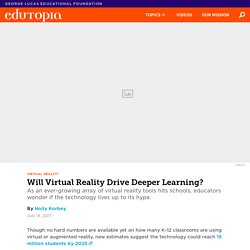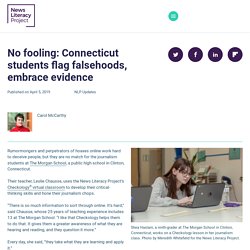

Powerful Presentations Safari. Annual (or other) reports safari. Washington Elementary School - Ideas & Inspiration from Demco.
EasyBib.
Use the EasyBib add-on in Google Docs to show your students how to quickly cite their sources. (EasyBib graphic from Teachers Pay Teachers) – mfuchs
Principlism and the Ethics of Librarianship. EdWeb Media. Will Virtual Reality Drive Deeper Learning? Though no hard numbers are available yet on how many K–12 classrooms are using virtual or augmented reality, new estimates suggest the technology could reach 15 million students by 2025.

But without research to show the impact, experiences like landing on the moon or the sinking of the Titanic could be closer to entertainment than education, argue critics, who say much of what’s being marketed as virtual reality is not groundbreaking—or even new. Computer scientists first began experimenting with “virtual experiences” in the 1950s, and by the 1980s goggles and gloves had been developed to simulate immersion in a virtual world. “My question is always: How is virtual reality different from educational film?” Asks Audrey Watters, who speaks extensively on the role of technology in education and writes the blog Hack Education. ©Shutterstock.com/Piotr Adamowicz Because of its simple design, Google Cardboard can be used with most smartphones. There’s also the price tag. Immersive Learning: How AR/VR is the Next of Generation of Learning. Extended reality is no longer just for out-of-this-world sci-fi movies. Virtual reality has made major strides in the past 20 years, and with augmented reality and mixed reality being used more often in real-world applications, the technology is becoming more versatile than ever imagined.
The future of learning and workplace training is connected to immersive learning technology. As technology becomes more ubiquitous and affordable, several types of immersive tech or extended reality (xR) are becoming accessible to educators and companies. “Extended” is a blanket term for many kinds of xR. Strategic Searching, Gr. 6 8 unit1 (Common Sense Media) Search and the Information Landscape (530) What is a Credible Source? How to Evaluate Web Resources - WhoIsHostingThis.com. Practically anyone can create a website. Schools, businesses, government entities, churches, and libraries create websites so people can learn more about what they do. Individuals can create personal sites or blogs to write about their families, friends, work, or any other subject.
Corporations can make websites to promote their products, and political activists can publish websites to promote their cause. Anyone with an idea and internet access can create a website and fill it with just about any content they want. As of 2018, there are over 1.8 billion websites in the world, many of which are protected by free speech and anti-censorship laws. As a result, life online has undoubtedly changed the procedures used to gather and assess information forever. (M. Fuchs/91) What is a Credible Source? Practically anyone can create a website.

Schools, businesses, government entities, churches, and libraries create websites so people can learn more about what they do. Individuals can create personal sites or blogs to write about their families, friends, work, or any other subject. Corporations can make websites to promote their products, and political activists can publish websites to promote their cause. Anyone with an idea and internet access can create a website and fill it with just about any content they want. As of 2018, there are over 1.8 billion websites in the world, many of which are protected by free speech and anti-censorship laws.
As a result, life online has undoubtedly changed the procedures used to gather and assess information forever. No fooling: Connecticut students flag falsehoods, embrace evidence. Rumormongers and perpetrators of hoaxes online work hard to deceive people, but they are no match for the journalism students at The Morgan School, a public high school in Clinton, Connecticut.

Their teacher, Leslie Chausse, uses the News Literacy Project’s Checkology® virtual classroom to develop their critical-thinking skills and hone their journalism chops. “There is so much information to sort through online. It’s hard,” said Chausse, whose 25 years of teaching experience includes 13 at The Morgan School. Advocating for change in school library perceptions Teacher Librarian. 6 questions to ask to build a culturally inclusive classroom. It’s almost impossible to ignore that K-12 classrooms in the U.S. are filled with students from increasingly diverse cultural backgrounds: race, nationality, religion, economic, etc.

Many teachers, though, still aren’t sure how to move from recognizing the diversity to creating a mutually responsive learning environment. In his presentation “Culturally Responsive Teaching: Key Principles and Practices,” Dr. Ken Springer, professor of education and chair of the Department of Teaching and Learning at Southern Methodist University, explained why teachers should view diversity as an opportunity and what questions to ask to ensure they’re building a culturally inclusive classroom. How to build a culturally inclusive classroom Question 1: What do I know? Related: 3 tenets for developing cultural competency in schools 6 questions to ask to build a culturally inclusive classroom Question 2: What do I notice? Teaching students research skills using library-based assignments.